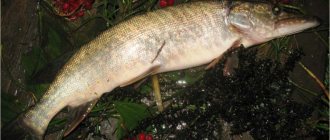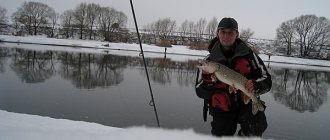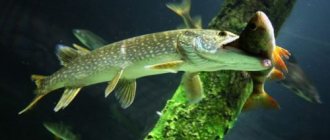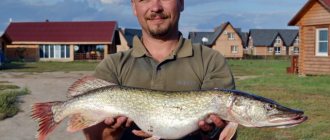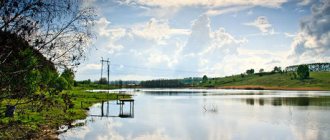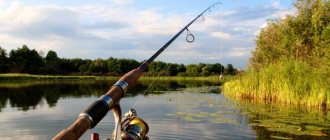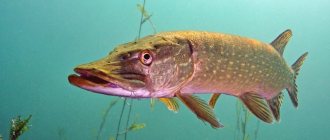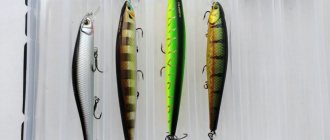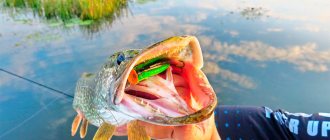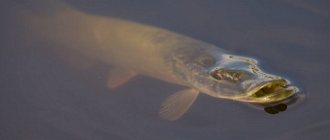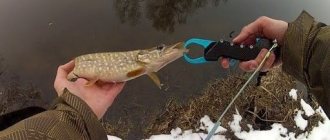Spring is a wonderful time of the year. Everything is blooming, awakening from winter sleep. Including fish. She begins to take an active interest in bait, so the fishing season in the spring is in full swing.
Today we will talk about catching pike with a spinning rod. The hunting season for this aquatic predator can be opened as soon as the ice has cleared from the river. However, you need to approach the process wisely, carefully preparing your gear and bait and finding out when and where the pike bites best. We will understand all these subtleties.
When does pike start biting on a spinning rod in the spring?
With the arrival of spring, the pike begins to eat. She strives to replenish energy reserves lost during the cold season.
The fish's pre-spawning feeding stage begins when the reservoirs are still covered in ice crust in many places. It lasts until spawning, which the fish begins not immediately after the ice melts, but after a short period of time. Therefore, as soon as the water warms up to 7-10 degrees above zero, you can start fishing - you will be satisfied and surprised by the result. At this time, going fishing is especially pleasant, since annoying mosquitoes and flies are still absent, which makes the process extremely comfortable.
During spawning, you can forget about biting and catch. Then the fish is still “sick” after it, regains strength and is not attracted to the bait. This lasts seven to ten days. But when the fish “gets sick”, it begins the second stage of the spring zhora. It is at this time that fishermen can get the fattest pike catch.
If we talk about the time of day, then in the spring you can catch pike with a spinning rod throughout the daylight hours, from morning to evening. In the first half of the day the chances of a good catch are slightly higher.
Catching pike at dusk in the spring is a futile task (unlike in the summer). In March and April there is nothing to do on the water after 8 pm, as well as very early in the morning. It is recommended to go out on the water at 9-10 am. However, there are exceptions to every rule; this is not mathematics with axioms!
The closer we get to summer, the more pronounced the division between morning and evening bites becomes. With the onset of the hottest time of the year, fishermen have to arrive at reservoirs earlier and earlier.
About
When to catch pike in spring
March. Pike begins to be actively caught already in the first month of spring. Since rivers are the first to be cleared of ice, this is where you can start fishing for pike with a spinning rod in the spring. In March, the toothy one experiences a pre-spawning feast, which occurs in pike earlier than all other fish.
But getting to this zhor is very difficult, since it lasts only 2-3 days, after which the pike goes to spawn. In times when there was no Internet, fishermen identified the pre-spawning toothfish by the flowering of rose hips. If you believe the old traditions, then the flowering of rose hips coincides with its zhor, which will last only a few days.
Toothed spawning can begin when the water temperature has only slightly exceeded +3 °C. Spawning occurs around the end of March and the first half of April, depending on weather conditions and the climatic zone of the region. Thus, when a white fish fry just hatches from its eggs, the pike fry has already grown up and hunts them, becoming a full-fledged predator.
The pre-spawning feast of pike is often prohibited from fishing in many regions. In each region, the legality of fishing during this period may differ, so in order to avoid problems with the law, first inquire about the period of the fishing ban. Almost everywhere, pike fishing is prohibited in March, so many people open the season when pike begins its post-spawning feast. And it begins approximately 1-2 weeks after spawning and lasts much longer than the pre-spawning period. Now the pike is ready to eat everything that moves, since the spawn took a lot of strength from the already weakened predator, moreover, during spawning it practically did not eat and its appetite is now excellent.
During spawning and for at least one week after it, pike are quite passive and do not respond to bait. During spawning, she simply has no time to hunt, and after it, the fish gets sick and now has no appetite at all. There is practically no point in catching it at this time - there will be no catch.
April. It is in April that the predator’s post-spawning meal occurs. This month is very favorable for catching it and now the main thing is not to miss these days, when pike rushes to almost any bait. Now is the opportunity to successfully fish for a predator even for those who are not particularly proficient in fishing techniques and are not particularly versed in wiring and other intricacies of spinning fishing.
Pike are not picky now and can actively attack baits that they wouldn’t even pay attention to in the summer. Now the predator’s goal is to replenish her reserves of strength and energy in order to enter her usual rhythm of life. In addition, now catching it is quite simple due to the fact that it is concentrated locally, not far from its spawning grounds. That is, in a small area of a reservoir there can be a fairly large concentration of toothed fish.
May. This month already brings with it significant warming. Pike fishing is now complicated by the fact that the predator scatters throughout the entire reservoir, occupying its usual parking spots, where it will stay all summer. Now local fishing will not work and searching for it will take much more time. The activity of the toothy fish is gradually decreasing, now it is becoming increasingly difficult to find the key to it, you often have to try many different baits, change wiring and plow the waters of the reservoir for a long time in search of it. Now it can be either near the reeds under the shore, or on deep-sea edges or in snags.
the most active pike biting time in the spring, since there is no clear boundary of activity, as in July. Perhaps we can say that the predator is a little more active in the morning hours - from 7:00 to 10:00 and in the evening, from 16:00 to 19:00. But during the day, pike activity can continue; sometimes you can’t even say that it is less active during the day. The water is cold, and during the day there is an opportunity to bask in the rays of the spring sun, which pike often take advantage of. The predator is comfortable, she warms up and her appetite does not subside even at lunchtime.
Spring pike fishing with spinning rod. Peculiarities
When catching predators in the spring, you need to take into account certain points, which cannot be said about summer or autumn fishing.
- It is best to fish in shallow water - the fish prefers to live in places with standing water, where the depth does not exceed 1.5 meters.
- It is recommended to use small-sized baits whose retrieve speed is low. The predator at this time is still weak after spawning and will not go after large prey, which, in addition, also moves quickly.
- In some regions there is a spawning ban on catching pike in the spring.
Fishing for pike in early spring with a spinning rod
As mentioned above, in early spring in some regions it is prohibited to catch pike by any means (including spinning). In addition, if the harsh winter is behind us, there is still ice in many bodies of water. So you should postpone your fishing trip.
If there is no spawning ban, and all the ice has disappeared, then it is better to hunt pike in small rivers and creeks, as well as at the mouths of streams that flow into lakes.
In March, there is very changeable air pressure and temperature, so it is unknown when a great bite will overtake you - in sunny or cloudy weather. The best time to fish this month is morning and evening.
During the pre-spawning period, pike attacks any bait, even the most primitive ones. Therefore, spinners have a chance of a good catch.
Pike on a spinning rod in April
In April, pike usually bite poorly and are caught using spinning rods. The fish is either in the process of spawning, or has just finished it, and therefore is “sick.” In addition, April is characterized by floods, when pike stand in the coastal zone, among the reeds.
If during this period the predator goes out hunting, it is only in shallow water, where it can profit from small fish. There is no point in looking for it at depth at this time.
About
Catching pike in the spring with a spinning rod from the shore
This is the most affordable and easiest option for a fisherman in the spring. You don't need any additional equipment like a boat for this. However, fishing from the shore has its own characteristics:
It is necessary to pay special attention to places where in the spring pike can be most effectively caught using a spinning rod. These are shallow waters well warmed by the sun, areas with aquatic vegetation and flooded bushes.
Spring fishing from the shore involves the use of rods with small weight (up to 20 grams) and a length of no more than 2.7 meters.
Pike fishing from the shore should be done as actively as possible - locations need to be changed extremely quickly. If after 10-15 casts there is no result, move to a new point.
Techniques for catching pike with a spinning rod in the spring and features of fishing from the shore and boat
When fishing for pike in the spring, you should move around as much as possible, fish all promising places, change baits often, and experiment with different types of fishing.
As during the entire season of spinning pike fishing in the spring, it is very important to correctly perform all its elements - from casting to hooking:
Casting When fishing on small lakes and small rivers, the most accurate and convenient will be a side or pendulum cast, in which the bait flies a short distance, and trees or bushes do not interfere with casting the bait. If you need to make a medium-range cast and there are no obstacles overhead in the form of tree branches or tall bushes on the shore, then it is better to perform a vertical whip cast.
With each cast, it is very important to control the free movement of the fishing line or cord through a series of guide rings on the form - to do this, fold back the line handle and hold the cord or line in the bend of the first phalanx of the index finger, bending the finger several times, and gently pull it up. If the cord is not twisted over the form and does not overlap the tip, it moves easily and effortlessly during this operation.
Neglecting such a simple operation when casting can seriously damage the tip of the blank or cause the bait to “shoot off” - due to the high inertial force, the leash attachment point breaks and the bait flies irrevocably into the water.
Wiring . For pike fishing in spring, the type and speed of retrieval depends on the type of bait used:
Spoon
To retrieve spinners at this time of year, use a uniform retrieve at a slow or medium speed. Also, when catching pike with oscillating large spoons, step-by-step jigs are often used on edges and drop-offs bordering shallows.
Video: catching pike in spring with a spoon
Wobblers
When fishing with wobblers, both “Stop and go” type wiring and standard twitching are used. At the same time, pauses lasting from 2 to 3-5 seconds are added to classic Twitch. When wiring “Stop and go”, uniform wiring of the wobbler alternates with pauses lasting 2-3 seconds. These retrieves are most effective when fishing with narrow and maneuverable Minnow class suspenders - when retrieved, they actively move from side to side, and when paused, they freeze in the water column, thereby giving the pike the opportunity to attack itself.
Video: catching pike with wobblers in spring
Jig lures
When fishing in the spring with silicone baits - twisters, vibrotails, slugs, worms - use standard stepped fishing. The reeling speed when retrieving should be slow or medium, the pauses between reelings should be longer than in summer. In areas with a clean bottom, the result can be achieved by the so-called bottom dragging - after casting and the bait falling to the bottom, the tip of the blank is lowered to the water and the bait is pulled along the bottom soil by slow reeling with short pauses.
Video: spring pike fishing with jig
Poppers
Fishing for pike with poppers is effective in May, when aquatic vegetation begins to appear on the surface of the water. The wiring of this bait is a standard twitching one with the difference that the jerks should be as frequent, short and sharp as possible - only in this case the concave nose part of the bait creates characteristic gurgling sounds that attract a predator.
Video: spring pike fishing with poppers
Sweeping. It is necessary to carry out a sweep at any suspicious blow. The hook should be sharp and short. A very strong and sweeping hook can, if caught on snags or grass, lead to breakage of the form.
Fishing. If the hook of the bait feels like a medium or small grass pike, and the angler is confident in the strength and reliability of his spinning rod, then you can catch such a fish simply by quickly pulling it to the shore
Large pike, which are often caught in the spring, should be fished out more delicately and carefully - if you force the process, the cord or fishing line may break, or the upper leg of the rod may break. Experienced spinning fishermen catch trophy specimens using the “pumping out” method - having pulled the fish to the shore with a rod, immediately removing the resulting slack by winding the reel, then performing a new pull, and so on until it is possible to take the predator with a landing net or, having run aground, pull it out hands.
In no case should you lift a large fish onto a high bank from the water on an outstretched line using a fishing rod - this can lead to a break in the form or a break in the cord when the fish jerks.
Fishing from the shore
Shore fishing with a spinning rod is the most affordable way to catch pike in the spring. It does not require a boat and has such distinctive features as:
- When fishing from the shore, special attention should be paid to those places where you can most productively catch pike in the spring with a spinning rod - well-warmed shallows and shallow waters, areas overgrown with last year's or fresh aquatic vegetation, snags and flooded bushes.
- When fishing for pike from the shore in spring, you should use rods with a small weight (up to 20 grams) and a length of no more than 2.7 meters. A universal spinning rod option for most reservoirs at this time will be a 2.4 meter rod with a test weight of 5 to 20 grams with a fast or ultra-fast action.
- Fishing of a promising place is carried out using a fan method - the bait is thrown several times at different angles to the shore, thereby covering a vast area of water.
- Shore fishing in the spring should be as active as possible - places should be changed very quickly. If after 10-15 casts there are no hits or fish caught, move on to the next one.
Video: spring shore fishing for pike with jig
Fishing from a boat
When planning to fish for pike from a boat in the spring, you should check whether there is a ban on the movement of boats and fishing from them. If there is no ban, then you can safely go to the reservoir. They catch pike from a boat at this time in those places where it is not possible to fish from the shore:
- in small, slow-flowing rivers with banks overgrown with bushes;
- in lakes with extensive shallow waters;
- in channels, ponds and bays with high thickets of last year's dry reeds.
Unlike shore fishing, when fishing from a boat, shorter rods with a weight of 5 to 15 grams are used. This is explained by the fact that by boat it is possible to sail as close as possible to a promising place, and there is no need for a long spinning rod and heavy bait.
The technique of catching pike from a boat is somewhat different from the shore one:
- The cast should be as soft and smooth as possible, otherwise the bait may end up on the branches of bushes or in reed thickets.
- When fishing for a pike (even a small one), you should not give it the opportunity to go under the boat; in most cases, this can lead to it getting lost.
- Having brought the predator to the side of the boat, it is carefully taken under the gills and abruptly thrown into the boat.
- It’s better to go fishing together, so that when you catch a large specimen, your partner can put the pike in a landing net or take it from the side with your hand and throw it into the boat
When fishing from a boat in shallow waters in the spring, it is better not to use a motor unless absolutely necessary - in the spring, in still water, fish, unlike a river, are very sensitive to noise.
Video: spring pike fishing on the lake using a spinning rod from a boat
Night fishing
Night fishing for pike in the spring is practiced if May is abnormally hot, and the predator switches to a summer feeding regime in advance due to a decrease in the oxygen content in the water and an increase in its temperature. In this case, the predator can be caught in the after-sunset hours at dusk, in the dark and several hours before dawn. At midnight she is inactive and practically does not feed.
You can learn all the secrets of catching pike with a spinning rod in the spring only by practicing hard. Only after walking more than one kilometer of rivers and streams, backwaters and bays, losing a lot of bait, feeling the tension of the fishing line and the cherished jerks of a hooked predator, every beginner eventually becomes a seasoned spinning angler.
